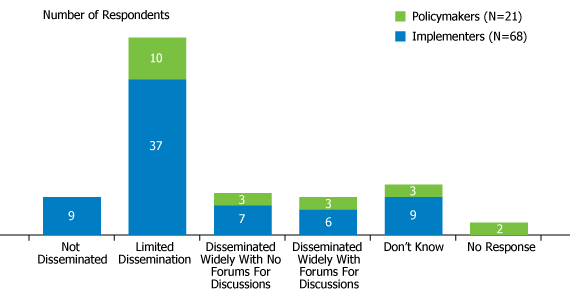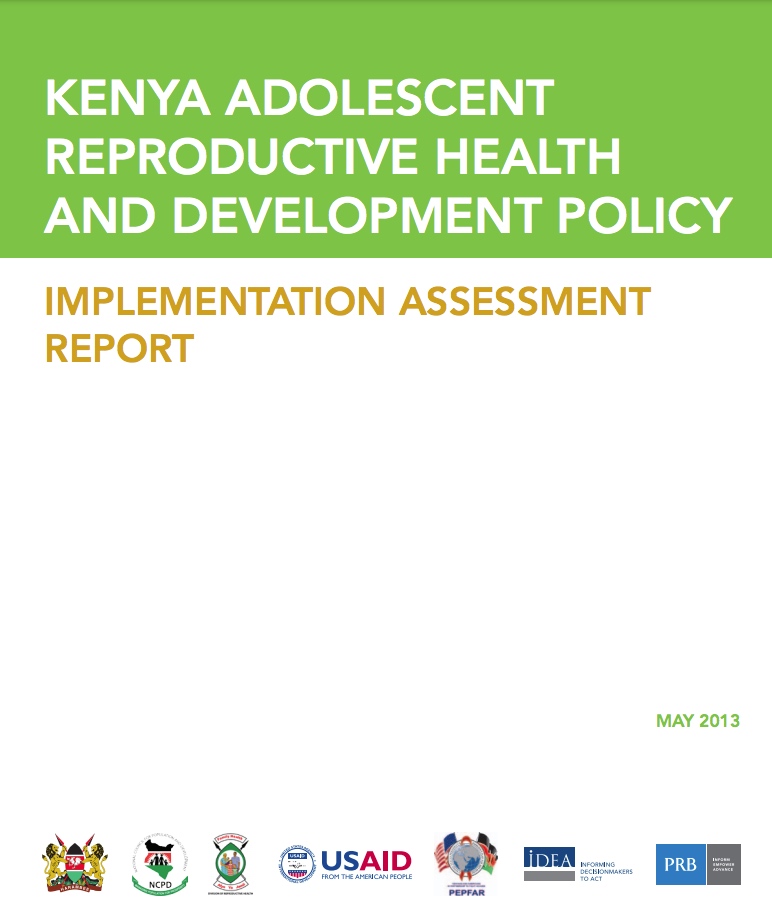
Kenya's Adolescent Reproductive Health and Development Policy: Implementation Progress and Barriers
(May 2013) Developed in 2003, the Adolescent Reproductive Health and Development (ARHD) Policy was the first in Kenya to focus on improving the reproductive health and well-being of adolescents and youth.1 Ten years since the policy was developed, Kenya has experienced much advancement and change in the social, economic, and political environment for ARHD. Both the government and the private sector have increased efforts to address the reproductive health and development needs of adolescents and youth. Key priorities and target populations have been identified to strengthen and expand programs and services, especially for the most underserved. Furthermore, new policies, strategies, and guidelines have been developed that reinforce the importance of reproductive health for adolescents and youth, such as the examples listed below.2
- National Guidelines for Provision of Youth-Friendly Services, 2005
- Kenya HIV & AIDS Prevention and Control Act, 2006
- Sexual Offences Act, 2006
- Ministry of Youth Affairs and Sports (MOYAS) Service Delivery Charter, 2007
- Gender Policy in Education, 2007
- National Youth Policy, 2007
- National Reproductive Health Policy: Enhancing Reproductive Health Status for All Kenyans, 2007
- Kenya Vision 2030, most notably the First Medium Term Plan, 2008-2012
- Ministry of Youth Affairs and Sports Strategic Plan, 2008-2012
- National Reproductive Health Strategy, 2009-2015
- Reproductive Health Communication Strategy, 2010-2012
- The Constitution of Kenya, 2010
- Kenya Health Sector Strategic Plan III, 2012-2017
- Population Policy for National Development, 2012-2030
The increased focus on youth is timely given the large size of Kenya’s young population today. A majority of the population is under age 20, and more than two out of five people are under age 15.3 Despite advancements for adolescent and youth sexual and reproductive health (SRH) programs, the latest data indicate a persistent high need for services. For example, more than one out of four young women is married by age 18, increasing their likelihood of having children at an early age. Nearly one out of three young married women has an unmet need for family planning, meaning they wish to delay childbearing, but are not using any method of contraception, and are at risk for having an unintended pregnancy. The table displays a longer list of adolescent and youth SRH indicators from the 2008-09 Kenya Demographic and Health Survey.
Kenya Adolescent and Youth Sexual and Reproductive Health
| Percent | |
|---|---|
| Women Ages 20-24 Married by Age 18 | 26 |
| Women Ages 20-24 Who Had Sex by Age 18 | 48 |
| Men Ages 20-24 Who Had Sex by Age 18 | 58 |
| Women Under Age 20 Whose Most Recent Birth Was an Unintended Pregnancy | 47 |
| Women Under Age 20 Whose Most Recent Birth Was Not Delivered by a Skilled Attendant | 52 |
| Married Women Ages 20-24 With an Unmet Need for Family Planning | 30 |
| Women Ages 20-24 Living With HIV | 6 |
| Men Ages 20-24 Living With HIV | 2 |
Source: Kenya Demographic and Health Survey 2008-2009 (Calverton, Maryland: Kenya National Bureau of Statistics and ICF Macro, 2010).
Given the increased focus on ARHD in Kenya over the last decade, the approaching end of the ARHD Policy timeframe, and the persistent need for ASRH care, stakeholders in Kenya recognized the importance of assessing ARHD Policy implementation. Therefore, the National Council for Population and Development, Division of Reproductive Health, and the Population Reference Bureau’s Informing Decisionmakers to Act (IDEA) Project conducted an assessment of the ARHD Policy in 2012.4
The ARHD Policy implementation assessment sought to examine policy progress and achievements; identify social, political, and economic barriers for implementation; and promote policy dialogue on ways to strengthen implementation. The assessment partners organized a task force of reproductive health professionals and youth advocates from the public and private sectors to provide input for the methodology and tools. Using an adapted version of the Health Policy Initiative’s 2010 Policy Implementation Assessment Tool, a core research team of PRB consultants collected qualitative data from 195 policy stakeholders at all levels. In Nairobi, Thika, Kisumu, Wajir, and Watamu, individual interviews were conducted with policymakers and policy implementers, and focus groups discussions were held with service providers, teachers, and youth.
The findings of the assessment reveal that since 2003, Kenya’s ARHD Policy has led to many perceived improvements in the health and well-being of adolescents and youth. The policy has provided guidance for priority ARHD needs and target populations, and for a range of approaches to increase access to and quality of programs and services. All of this has contributed to more commitment to and funding for adolescent SRH; strengthened partnerships between the government and private sector partners; improved knowledge of and attitudes toward ASRH; and empowered youth.
However, ARHD Policy implementation has been limited due to a range of factors, such as: lack of awareness about the policy; lack of coordination among implementers; low stakeholder involvement, including low political will and youth involvement; limited leadership; lack of resources; poverty and unemployment among youth; and limited availability of high-quality ASRH services. Additionally, adolescent SRH remains a contentious issue among some communities, and some cultural and religious practices are barriers for implementation.
One of the main challenges for implementation has been lack of awareness about the ARHD Policy. In the regions visited, policy awareness was mainly at the provincial level, and the policy was not well-known beyond this, especially in more rural areas. The policy was also not well-known among institutions with high turnover of personnel, and among policymakers. Lack of policy awareness is no surprise given the concerns expressed about limited policy dissemination among policymakers and policy implementers interviewed for the assessment (see figure). Due to limited policy dissemination and awareness, many stakeholders are uninformed regarding the policy objectives and implementation strategy, the agencies responsible for implementation, and the monitoring and evaluation (M&E) framework.
The Extent of ARHD Policy Dissemination to Implementing Agencies

Source: Kenya Adolescent Reproductive Health and Development Policy Implementation Assessment Report(Nairobi, Kenya: National Council for Population and Development, Division of Reproductive Health, and Population Reference Bureau, 2013).
Based on the findings, the assessment partners and stakeholders identified seven recommendations to strengthen policy implementation:
1. Ensure an Integrated Approach to Policy Development and Implementation
- Revise ARHD Policy Into a National Adolescent and Youth Development Policy
- Foster Multisectoral Engagement
- Ensure Adolescent and Youth Involvement
- Foster Parental Involvement
2. Strengthen Leadership and Coordination
- Strengthen Leadership
- Improve Coordination Among Stakeholders and Implementers
3. Increase Policy Awareness
- Scale-Up Nationwide Policy Dissemination
4. Strengthen Implementation Plans
- Develop and Implement a Comprehensive Plan of Action
5. Improve Resource Mobilization and Management
- Improve Resource Mobilization With Clear Leadership
- Strengthen Financial Oversight and Accountability
6. Improve Service Delivery
- Provide Capacity Building for Policy Implementation
- Increase Adolescent/Youth Access to Services
7. Ensure Monitoring and Evaluation
- Establish and Implement an M&E Framework With Clear Leadership
- Provide Capacity Building for M&E Among Implementers
In the coming years, the ARHD Policy implementation assessment findings and recommendations will be used by stakeholders to develop a new national adolescent and youth development policy with reproductive health at its core. A new multisectoral youth policy with a stronger emphasis on policy dissemination and implementation is expected to improve the health and well-being of Kenya’s young people, and contribute to national development.
Maura Graff is a policy analyst in International Programs at PRB.
References
- Republic of Kenya, Adolescent Reproductive Health and Development Policy (Nairobi: National Council for Population and Development, Ministry of Planning and National Development, and Division of Reproductive Health, Ministry of Health, 2003).
- Kenya Adolescent Reproductive Health and Development Policy Implementation Assessment Report (Nairobi: National Council for Population and Development, Division of Reproductive Health, and Population Reference Bureau, 2013).
- The 2009 Kenya Population and Housing Census (Kenya National Bureau of Statistics, 2010).
- Kenya Demographic and Health Survey 2008-2009 (Calverton, MD: Kenya National Bureau of Statistics and ICF Macro, 2010).
- Kenya Adolescent Reproductive Health and Development Policy Implementation Assessment Report (Nairobi: National Council for Population and Development, Division of Reproductive Health, and Population Reference Bureau, 2013).

 ">
">